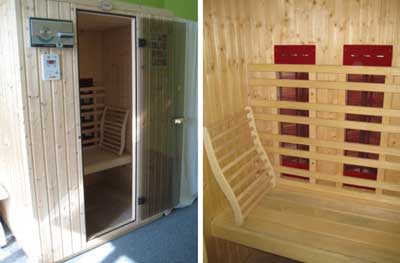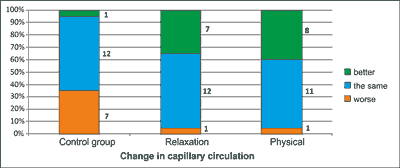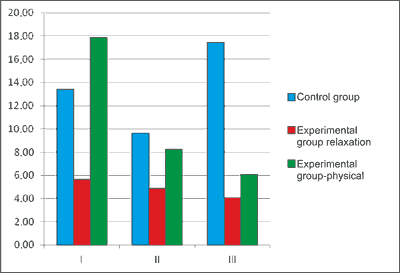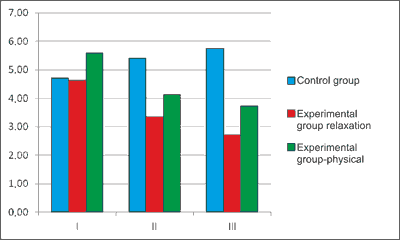© Borgis - New Medicine 1/2013, s. 3-8
*Aneta Dąbek, Janusz Domaniecki, Piotr Czyżewski, Małgorzata Bujar-Misztal
Evaluation of selected therapeutic methods in patients with primary Raynaud”s syndrome
Department of Rehabilitation, Józef Piłsudski University of Physical Education, Warsaw, Poland
Head of Department: Małgorzata Łukowicz, MD, PhD, assoc. Prof.
Summary
Introduction. The only treatment method for individuals with primary Raynaud”s widely used in Poland, is drug therapy.
Aim. The aim of the study was to demonstrate experimentally that other non-pharmacological treatment for primary Raynaud”s sufferers are possible, and to determine their efficacy.
Material and methods. The paper describes and discusses the results of comprehensive assessment of 60 patients of the Department of Dermatology. The patients were randomly assigned to a control group and two experimental groups (relaxation therapy and physical therapy, 20 patients each). As it would be unethical to deny treatment to those patients assigned to the control group, that group received drug therapy alone, while the other two groups received drug therapy plus additional treatments (infrared sauna or relaxation training). All patients were assessed on three occasions: at baseline (before the experiment) (I), and after twelve (II) and twenty-four (III) weeks of treatment. The paper presents the results of assessment of changes in capillary circulation (by capillaroscopy), pain, sweating (VAS scale), frequency of Raynaud”s attacks (questionnaire), and level of anxiety (STAI questionnaire).
Results. The experimental groups (physical therapy and relaxation therapy) demonstrated significantly better results on capillaroscopic examination after 24 weeks of treatment compared to the control group (p = 0.015 and p = 0.030, respectively). After 24 weeks of treatment, the physical therapy group reported a lower level of pain than the control group at p = 0.032.
Conclusions. The results of the study show that the health-related problems of patients with primary Raynaud”s require an interdisciplinary approach.
INTRODUCTION
The Raynaud”s syndrome is a paroxysmal vasoconstriction of peripheral arterioles in hands, more rarely feet, ears, tongue or mamma. The contraction lasts 15 to 45 minutes. During the ischemic paroxysm an intensive paleness of the fingers is observed and the patient complains of sensory disorders, also called ‘numb” fingers. After the ischemic paroxysm, redness and finger swelling is visible and the patient experiences strong pulsing pain (1-3).
The Raynaud”s disease pathomechanism has not been thoroughly explored.
Excessive mental excitation (stress) and cold are considered as the main cause of primary Raynaud”s syndrome (4).
Studies (5) shown a strong connection between Raynaud”s disease and affection of nail plates and exacerbation of mycosis. Apart from typical mycotic changes, untreated Raynaud”s disease may lead to shallow nail ruptures, whitlow and ulcerations (2).
The only treatment method for individuals with primary Raynaud”s widely used in Poland, is drug therapy. Preferred are the preparations with prolonged action as they lower the risk of side effects such as headaches, skin redness, blood pressure drop and gastro-esophageal reflux. Pharmacotherapy often doesn”t bring expected result, requires huge expenses and is inconvenient for the patient – medications need to be administered 3 to 4 times daily (4, 6).
Researchers (7-9) proved the efficacy of analgesic laser therapy in patients with primary Raynaud”s syndrome.
Foreign literature widely describes the therapy of patients with primary Raynaud”s employing the biofeedback phenomenon (10).
Few authors (4, 10, 11) claim that relaxation and acupuncture should be primal part of primary Raynaud”s syndrome treatment, especially in patients, in whom the stress is the main trigger of ischemic attacks.
AIM
The aim of the study was to demonstrate experimentally that other non-pharmacological treatment for individuals with primary Raynaud”s is possible, to determine their efficacy and to evaluate patients” subjective sentiments towards experimental forms of therapy.
Following hypothesis was assumed:
1. IR sauna has therapeutic values in rehabilitation of patients with primary Raynaud”s syndrome.
2. Relaxation constitutes the efficient form of therapy in rehabilitation of patients with primary Raynaud”s syndrome.
In order to verify the above hypothesis, the following experimental question was asked:
1. Will the therapy proposed in experimental groups lead to significant improvement of the following factors:
– capillary circulation
– hand pain reduction
– hand sweating reduction
– decrease of Raynaud”s syndrome frequency
MATERIAL AND METHODS
The study included 98 patients with Raynaud”s disease aged between 18 and 50 years-old. Patients have been undergoing an ambulatory treatment in Dermatology Clinic of Warsaw Medical University. Qualification for the study was based on the completion of the following criteria:
Age over 18 years.
– History of clinical symptoms characteristic for the primary Raynaud”s phenomenon for at least two years.
– Characteristic capillaroscopic image (blood congestion, vasospasm, Raynaud”s loops).
– Absence of concomitant disease justifying the primary Raynaud”s phenomenon.
– Drug therapy with pentoxifylline prescribed by dermatologist.
– Absence of contraindications for the use of IR sauna.
Patients with Raynaud”s disease were qualified to three following groups: control and two experimental groups with physical and relaxation therapy. The therapy lasting 24 weeks was successfully finished by 60 individuals. Table 1 shows characteristics of the study group including group abundance, age and sex.
Table 1. Study group characteristics.
| Characteristic | Group |
| Control | Experimental |
| Relaxation | Physical therapy |
| n (number of patients) | 20 | 20 | 20 |
| Sex (F; M) | 20F | 19F; 1M | 20F |
| Age (years) | 33 ± 13 | 25 ± 4 | 33 ± 10.5 |
The study was conducted with the permission of Senate Ethical Committee for Scientific Research of Józef Piłsudski University of Physical Education in Warsaw (SKE 001/18-1/2007).
Patients with Raynaud”s disease participated in evaluation three times: at the therapy baseline (I examination), after 12 weeks of therapy (II examination) and after 24 weeks of therapy (III examination). Following parameters were evaluated: microcirculation and hand sweating, pain, anxiety level. To asses the efficacy of applied therapeutic procedures, following methods were used.
Capillary circulation
Capillaroscopic examination was carried out in order to assess changes in both hands” microcirculation (12).
Due to a high cost of this method, capillaroscopy was conducted twice – before (I examination) and after the therapy (II examination). Comparative three degree scale was applied, in which “-1” indicated deterioration, “0” – absence of changes and “1” indicated improvement.
Hand pain evaluation
Evaluation of hand pain was established with the use of Visual Analogue Scale (VAS). The VAS scale is a horizontal line, 10 cm in length, with labels anchored at each end (the minimum and the maximum), on which the patient marks the point representing the intensity of perceived pain. The result is presented in millimeters (distance between the point and the left end of the stretch) (13). Patients indicated the usually perceived pain.
Hand sweating
Hand sweating evaluation was also conducted employing VAS scale. Patients indicated the usual hand sweating degree
Frequency of ischemic attacks
Assessment of the Raynaud”s syndrome recurrence was carried out based on one week”s period. The study participants answered the following question: “How often do you experience Raynaud”s symptoms?”
A. once a week
B. twice a week
C. three times a week
D. more frequently (how often?)
Statistical analysis
The study data were analyzed with the use of SPSS statistical package ver.14. Kolmogorov-Smirnov test was used to estimate probability distributions. Multi-factorial ANOVA was used to compare values of the parameters such as: hand pain, hand sweating, symptom”s frequency per week. The Kruskal–Wallis one-way analysis of variance was used to test the quality of capillary circulation medians among groups. The lowest range of significance level was set at p ≤ 0.05.
Control group
As it would be unethical to deny treatment to patients assigned to the control group, this group received pharmacotherapy alone, while the other two groups received pharmacotherapy and additional treatments (infrared sauna or relaxation training). All individuals taking part in the study were administered pentoxifylline, prescribed by a dermatologist, twice a day. Therapy among patients with Raynaud”s disease lasted for 24 weeks.
Experimental group – relaxation
Each patient included in the relaxation experimental group was given the CD with recorded training and were obliged to conduct relaxations sessions daily, gradually prolonging the training time from 5 minutes up to 20 minutes. Once a week, individual 45-minute training took place with leader”s participation, during which, with the use of relaxation programs and biofeedback, patients perfected their proper relaxation abilities (fig. 1).

Fig. 1. Infrared (IR) sauna, outside and inside look [own materials].
Blue Watcher device was used for relaxation training and monitoring the progress. The device may also serve to record relaxation level during the session and to compare individual recordings.
Blue Watcher device informs on relaxation level by measuring the galvanic skin response as well as visual and auditory stimulus.
Physical therapy group
The study was conducted at the Chair of Rehabilitation of the University of Physical Education in Warsaw. Patients included in this group were subjects to infrared sauna sessions.
For research purposes, a German production IR sauna was used, a model available for public and possible to use at home.
Patients with Raynaud”s disease attended IR sauna sessions three times a week for 24 weeks. Each session lasted 30 minutes. Before the session, sauna was pre-warmed to a temperature of 65°C. The source of heat was the IR-C radiation, with the wave length of 12000 nm, from the range of so called far infrared. After the sauna sessions, patients showered, dressed up and took a rest in lying position for minimum 15 minutes.
RESULTS
Changes in the capillary circulation
Statistically significant differences were demonstrated in capillaroscopy results, depending on the group: chi2(2) = 12.50; p = 0.002. Patients from physical therapy group and relaxation therapy group demonstrated significantly better results in capillaroscopy compared to the control group (p = 0.015 and p = 0.030, respectively) (fig. 2).

Fig. 2. Changes in capillary circulation after 24 weeks of therapy according to groups.
Hand pain assessment
Figure 3 demonstrates changes in mean values of VAS scores concerning hand pain in the studied groups.

Fig. 3. Changes in mean VAS score values concerning hand pain in the studied groups.
Concerning the physical therapy group, it was demonstrated that mean value of VAS score in the third assessment was significantly lower (p = 0.032) comparing to first assessment. It indicates that pain level in physical therapy group decreased significantly. In the control and relaxation therapy groups mean VAS values did vary significantly in subsequent assessments.
Hand sweating
Figure 4 demonstrates changes in mean VAS values concerning hand sweating among studied groups of patients with primary Raynaud”s syndrome.

Fig. 4. Changes in mean VAS score values indicating hand sweating in studied groups.
In physical therapy group it was demonstrated that mean values of VAS score indicating hand sweating was significantly lower in the second and third assessment comparing to first measurement (p = 0.005 and p = 0.008 respectively). It indicates that hand sweating in physical therapy group decreased significantly.
In relaxation therapy group, mean VAS score values indicating hand sweating in the third and second assessment were also significantly lower comparing to the first assessment (p = 0.003 and p = 0.012 respectively). It indicates that hand sweating in relaxation therapy group also decreased significantly.
Frequency of Raynaud”s syndrome incidence.
Figure 5 demonstrates changes in mean values of Raynaud”s syndrome incidence in studied groups.

Fig. 5. Changes in mean values of Raynaud”s syndrome incidence in studied groups.
Patients from relaxation therapy and physical therapy groups reached significantly lower mean values of Raynaud”s syndrome incidence in comparison to control group (p = 0.001 and p = 0.003 respectively).
DISCUSSION
Patients with primary Raynaud”s syndrome, apart from traditionally applied pharmacotherapy, were subjected to IR sauna sessions and relaxation training. The therapy choice wasn”t fortuitous.
There are no scientific reports on IR sauna utilization in primary Raynaud”s treatment. Infrared radiation however has been used in physiotherapy for several years to fight pain and to treat chronic inflammations. IR sauna sessions in patients with primary Raynaud”s were assumed to favorably influence blood circulation in distal blood vessels. After 24 weeks of therapy, capillary circulation improvement was observed in 40% patients of physical therapy group (7 patients). For comparison, only one person from the control group demonstrated improvement. IR sauna sessions” safety was proved by Chinese and Japanese researchers. They conducted IR sauna sessions in patients with heart attack risk factors, chronic heart failure (14), arterial hypertension (15) and with depressive episodes (16).
In our study, the advantageous influence of IR sauna on decrease of pain level was confirmed. After 24 weeks of therapy, patients from experimental – physical therapy group reported significantly lower pain level than before the therapy.
Widely known, IR sauna beneficial effect on water-electrolyte balance has not been confirmed and after 24 weeks of therapy in physical groups, no significant changes in hand sweating were reported. Although a significant differences in hand sweating were seen comparing physical therapy group and control group.
In the winter time, many patients with primary Raynaud”s syndrome complain about more frequent ischemic attacks. The effect of “warm extremities” felt by the patients and inducted by the warm produced in IR sauna, lasted even up to several hours after the session. This may be the reason for the significant decrease in ischemic attacks frequency in the physical therapy group.
The Raynaud”s syndrome and its primary form in particular, are considered as psychosomatic illnesses.
Some researchers (17), emphasize that patients with Raynaud”s symptom demonstrate problems with relaxation training. Kulmatycki and Miedzińska (17) proved that desired relaxation state is not a question of chance. Huge role is played by individual susceptibility to relaxation and nervous system strength as well as balance of nervous processes.
In the research by Kostrzewa-Jabłonka (18), patients identified as neurotic have not achieved any effect of rehabilitation. In my opinion Kostrzewa-Jabłonka rightly points out the necessity of involvement of psychotherapeutic activities in physiotherapy process. She claims that personality evaluation may improve the chance of an adequate choice of the therapy, therefore increasing the efficacy of treatment.
Random allocation to experimental groups proposed in our study may understate therapeutic results. Subject with better relaxation abilities might present a better tolerance do sauna. However the experiment”s method (19) excludes intentional patient”s allocation to therapeutic groups.
The above work is an attempt of an interdisciplinary approach towards the health problems of patients with a primary Raynaud”s syndrome.
CONCLUSIONS
Own research result presented in the above work authorize to formulate the following conclusions:
1. Patients from both experimental groups, physical therapy and relaxation group, achieved better results in capillaroscopic examination, than patients from the control group.
2. Due to therapy”s influence, decrease in pain level was observed only in physical therapy group.
3. Hand sweating has dropped significantly in both experimental groups (physical therapy and relaxation).
4. Reynaud”s syndrome frequency was significantly lower in both experimental groups – relaxation and physical therapy, than in the control group.
Piśmiennictwo
1. Choi WS, Choi CJ, Kim KS et al.: To compare the efficacy and safety of nifedipine sustained release with Ginkgo biloba extract to treat patients with primary Raynaud”s phenomenon in South Korea; Korean Raynaud study. Clinical Rheumatology 2009; 28(5): 553-559. 2. Rychlik-Golema W, Adamiec R, Bednarska-Chabowska D, Adamiec J: Fenomen Raynaud – wciąż aktualny problem kliniczny. Przegląd Lekarski 2002; 59(1) 49-54. 3. Aron JH, Fink GW, Swartz MF et al.: Cerebral oxygen desaturation after cardiopulmonary bypass in a patient with Raynaud”s phenomenon detected by near-infrared celebral oximetry. Anesth Analog 2007; 104: 1034-1036. 4. Cooke JP, Marshall JM: Mechanism of Raynaud”s disease. Vascular Medicine 2005; 10: 293-307. 5. Araviiskaya ER, Kutznetzov AV, Petrischev NN et al.: Analysis of microcir ulation and regional blood flow in the patients with onychomycosis and Raynaud disease. Dermatologia Kliniczna 2004; 6(2): 71-74. 6. Puszczewicz M: Objaw Raynauda – problem interdyscyplinarny. Forum Medycyny Rodzinnej 2008; 2(2): 121-126. 7. Al-Awami M, Schillinger M, Maca T: Low level laser therapy for treatment of primary and secondary Raynaud”s phenomenon. Vasa 2004; 1: 25-29. 8. Hirschl M, Katzenschlager R, Francesconi C, Kundi M: Low level laser therapy in primary Raynaud”s phenomenon – results of a placebo contolled, double blind intervention study. J Rheumatol 2004; 31(12): 2406-2412. 9. Kita J, Kuryliszyn-Moskal A, Dakowicz A: Biostymulacja laserowa terapii zaburzeń mikrokrążenia u pacjentów z objawem Raynauda. Post NMed 2012; 2: 95-98. 10. Middaugh JS, Haythornthwaite AJ, Thompson B et al.: The Raynaud”s Treatment Study: Biofeedback Protocols and Acquisition of Temperature Biofeedback Skills. Applied Psychophysiology and Biofeedback 2001; 26(4): 251-278. 11. Garcia-Carrasco M, Jimenez- -Hernandez M, Escarcega RO et al.: Treatment of Raynaud”s phenomenon. Autoimmun Rev 2008; 8(1): 62-68. 12. Michalska-Jakubus M, Chodorowska G, Krasowska D: Kapilaroskopia wału paznokciowego. Mikroskopowa ocean zmian morfologicznych mikrokrążenia w twardzinie układowej. Postępy Dermatologii i Alergologii 2010; 2: 106-118. 13. Cepuch G, Wordliczek J, Golec A: Wybrane skale do badania natężenia bólu u młodzieży-ocena ich przydatności. Polska Medycyna Paliatywna 2006; 5(3): 108-113. 14. Kihara T, Biro S, Imamura M et al.: Repeated sauna treatment improves vascular endothelial and cardiac function in patients with chronic heart failure. J AM Coll Cardiol 2002; 39: 754-759. 15. Masuda A, Nakazato M, Kihara T et al.: Repeted thermal therapy dismishes appetite loss and subjective complaints in midly depressed patients. Psychosomatica Medicine 2005; 67(4): 643-647. 16. Masuda A, Koga Y, Hattamaru M et al.: The effects of repeated thermal therapy for patient with chronic pain. Psychother Psychosom 2005; 74(5): 288-294. 17. Kulmatycki L, Miedzińska B: Podatność na relaksację a cechy osobowości. Postępy Rehabilitacji 1999; 3: 151-159. 18. Kostrzewa-Jabłonka M: Wpływ wysokiego poziomu napięcia na efekty leczenia w wyniku kompleksowej fizjoterapii chorych z dyskopatią szyjną i lędźwiową. Postępy Rehabilitacji 1999; 2: 81-88. 19. Brzeziński J: Metodologia badań psychologicznych. PWN, Warszawa 2007.




